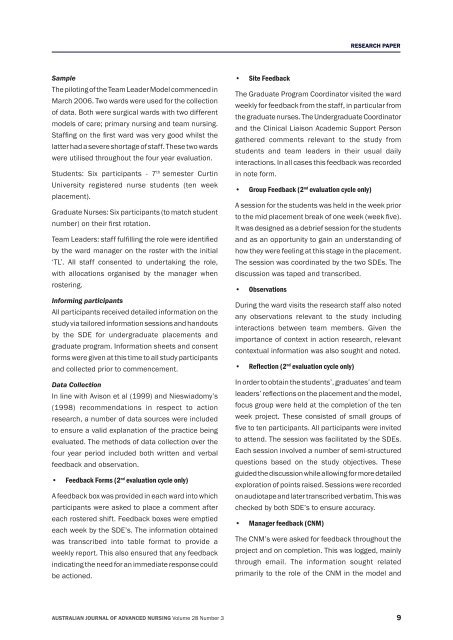australian journal of advanced nursing
australian journal of advanced nursing
australian journal of advanced nursing
You also want an ePaper? Increase the reach of your titles
YUMPU automatically turns print PDFs into web optimized ePapers that Google loves.
Sample<br />
The piloting <strong>of</strong> the Team Leader Model commenced in<br />
March 2006. Two wards were used for the collection<br />
<strong>of</strong> data. Both were surgical wards with two different<br />
models <strong>of</strong> care; primary <strong>nursing</strong> and team <strong>nursing</strong>.<br />
Staffing on the first ward was very good whilst the<br />
latter had a severe shortage <strong>of</strong> staff. These two wards<br />
were utilised throughout the four year evaluation.<br />
Students: Six participants ‑ 7 th semester Curtin<br />
University registered nurse students (ten week<br />
placement).<br />
Graduate Nurses: Six participants (to match student<br />
number) on their first rotation.<br />
Team Leaders: staff fulfilling the role were identified<br />
by the ward manager on the roster with the initial<br />
‘TL’. All staff consented to undertaking the role,<br />
with allocations organised by the manager when<br />
rostering.<br />
Informing participants<br />
All participants received detailed information on the<br />
study via tailored information sessions and handouts<br />
by the SDE for undergraduate placements and<br />
graduate program. Information sheets and consent<br />
forms were given at this time to all study participants<br />
and collected prior to commencement.<br />
Data Collection<br />
In line with Avison et al (1999) and Nieswiadomy’s<br />
(1998) recommendations in respect to action<br />
research, a number <strong>of</strong> data sources were included<br />
to ensure a valid explanation <strong>of</strong> the practice being<br />
evaluated. The methods <strong>of</strong> data collection over the<br />
four year period included both written and verbal<br />
feedback and observation.<br />
•<br />
nd Feedback Forms (2 evaluation cycle only)<br />
A feedback box was provided in each ward into which<br />
participants were asked to place a comment after<br />
each rostered shift. Feedback boxes were emptied<br />
each week by the SDE’s. The information obtained<br />
was transcribed into table format to provide a<br />
weekly report. This also ensured that any feedback<br />
indicating the need for an immediate response could<br />
be actioned.<br />
Site Feedback<br />
RESEARCH PAPER<br />
AUSTRALIAN JOURNAL OF ADVANCED NURSING Volume 28 Number 3 9<br />
•<br />
The Graduate Program Coordinator visited the ward<br />
weekly for feedback from the staff, in particular from<br />
the graduate nurses. The Undergraduate Coordinator<br />
and the Clinical Liaison Academic Support Person<br />
gathered comments relevant to the study from<br />
students and team leaders in their usual daily<br />
interactions. In all cases this feedback was recorded<br />
in note form.<br />
•<br />
nd Group Feedback (2 evaluation cycle only)<br />
A session for the students was held in the week prior<br />
to the mid placement break <strong>of</strong> one week (week five).<br />
It was designed as a debrief session for the students<br />
and as an opportunity to gain an understanding <strong>of</strong><br />
how they were feeling at this stage in the placement.<br />
The session was coordinated by the two SDEs. The<br />
discussion was taped and transcribed.<br />
•<br />
Observations<br />
During the ward visits the research staff also noted<br />
any observations relevant to the study including<br />
interactions between team members. Given the<br />
importance <strong>of</strong> context in action research, relevant<br />
contextual information was also sought and noted.<br />
•<br />
nd Reflection (2 evaluation cycle only)<br />
In order to obtain the students’, graduates’ and team<br />
leaders’ reflections on the placement and the model,<br />
focus group were held at the completion <strong>of</strong> the ten<br />
week project. These consisted <strong>of</strong> small groups <strong>of</strong><br />
five to ten participants. All participants were invited<br />
to attend. The session was facilitated by the SDEs.<br />
Each session involved a number <strong>of</strong> semi‑structured<br />
questions based on the study objectives. These<br />
guided the discussion while allowing for more detailed<br />
exploration <strong>of</strong> points raised. Sessions were recorded<br />
on audiotape and later transcribed verbatim. This was<br />
checked by both SDE’s to ensure accuracy.<br />
•<br />
Manager feedback (CNM)<br />
The CNM’s were asked for feedback throughout the<br />
project and on completion. This was logged, mainly<br />
through email. The information sought related<br />
primarily to the role <strong>of</strong> the CNM in the model and

















